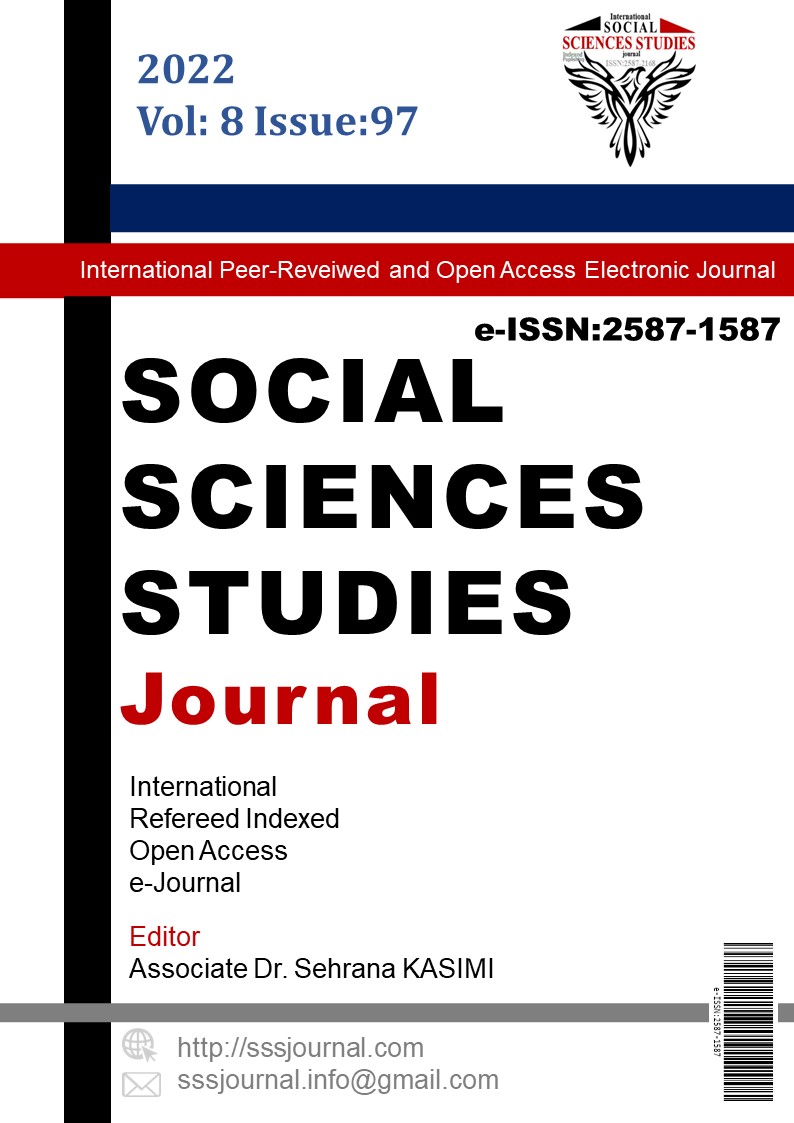Author :
Abstract
Çalışmada Selçuklu ve Osmanlı dönemi cami mimarisi estetik açıdan değerlendirilmeye çalışılmış ve karşılaştırmalı bir yaklaşımla ele alınmıştır. Çalışmada her iki devlet döneminde ortaya koyulan cami mimarisinin üzerinde etkili olan dini ve dönemsel özellikler vurgulanmıştır. Tasarlanan camilerde Türk- İslam mimarisi Allah’ı taklit ederek güzele ulaşma fikriyle yola çıkan ve daha sonra estetik kaygıları da içine alan bir gelişim evresi Selçuklular döneminden başlamaktadır. Osmanlı dönemini ele aldığımızda Türk-İslam mimarisi eserlerin özellikle Mimar Sinan döneminde doruğa ulaştığı görülmektedir. Mimar Sinan döneminde pek çok eser ortaya koyulmuş ve özellikle simetri anlayışı bu döneme damga vurmuştur. Genel çerçevede Selçuklu ve Osmanlı dönemi mimarisi değerlendirildiğinde en önemli farklılığın simetri olduğu görülmüştür. Bunun en önemli nedeni, simetrinin, diğerlerinden farklı olarak camilerin tüm mekânlarını etki edecek düzeyde bir unsur olmasıdır. Ayrıca çalışmanın sonunda, estetik kaygılarla yapılsa da Selçuklu camilerinin genellikle aşamalı olarak inşa edilmesi ve farklı mimarlar tarafından yapılması nedeniyle organik bütünlüğünü koruyamadığı buna karşın Osmanlı camilerinin belirli bir planla yapıldığından daha estetik görünüme sahip olduğu tespit edilmiştir
Keywords
Abstract
This study aimed to determine and compare the aesthetics of Seljuk and Ottoman mosques in terms of architecture and the most important features of both religious architectures were presented with a comparative approach. In the study, the religious and periodical features being effective on the mosque architecture, which were revealed in both state periods, were emphasized. Starting with the idea of achieving beauty by imitating Allah, Turkish-Islamic architecture started to design mosques with aesthetic concerns starting from the Seljuk period. The architecture of the Turkish-Islamic mosque has reached its peak in aesthetic terms during the reign of Mimar Sinan. The main reason for this is the application of symmetry in all the mosques. This situation also shows the most important difference between Seljuk mosque architecture and Ottoman mosque architecture. As a result, albeit being built with aesthetic concerns, Seljuk mosques could not preserve their organic integrity since they were built gradually and built by different architects; on the other hand, Ottoman mosques had more aesthetic appearance than they were built with a specific plan.
Keywords
- Akbaş, G., Erçetin A. & Kutlu, R. (2020). "İznik’te Erken Dönem Osmanlı Mimarisi Örnekleri: Zaviye, İmaret,
- Akbaş, G., Erçetin A. & Kutlu, R. (2020). "İznik’te Erken Dönem Osmanlı Mimarisi Örnekleri: Zaviye, İmaret, Cami", The Turkish Online Journal of Design Art and Communication, 10(2): 116-126.
- Armağan, M. (2006). “İslam: Sanat ve Estetik”, İslam’a Giriş, ss. 388-407, Diyanet İşleri Başkanlığı Yayınları, Ankara.
- Aslanapa, O. (1989). Turkish Art (Türk Sanatı), Remzi Kitabevi, Ankara.
- Atçeken Z. & Bedirhan Y. (2012). Selçuklu Müesseseleri ve Medeniyet Tarihi, Eğitim Yayınevi, Konya.
- Aydın, R. (2014). “Konya Alâeddin Camisi’nin Korunmasına Yönelik Girişimler (1889-1897)”, Turkish Studies, 9(10): 33- 60.
- Ayvazoğlu, B. (1992). İslam Estetiği, Ağaç Yayıncılık, İstanbul.
- Bulat, S., Bulat M. & Aydın, B. (2014). “Bauhause Tasarım Okulu”, Journal of Atatürk University Social Sciences Institute, 18(1): 105-120.
- Cevizci, A. (1997). Felsefe Sözlüğü, Ekin Yayınları, Ankara.
- Doğan, T. (2013). “Osmanlı Cami Mimarisi’nde Aydınlatma Düzenleri Açısından Gelişim (XIV.- XVII. Yüzyıl)”, YYU Journal of Education Faculty, 10(1): 295- 320.
- Erarslan, A. (2018). “Mimar Sinan’ın Altıgen Baldaken Sistemli Camilerinde Taşıyıcı, Örtü ve Mekân İlişkisi”, Journal of Ottoman Legacy Studies, 5(13): 31-48.
- Erden, E. (2019). “Bauhaus Ekolü’nün Erken Cumhuriyet Dönemi Modernleşmesi Üzerine Etkileri: 1933’teAlmanya’dan Göç Eden Bilim İnsanlarının Türkiye Sanat Eğitimine Katkıları”, Master Thesis, Sakarya University, Sakarya.
- Faroqhi, S. (2006). Osmanlı’da Kentler ve Kentliler (Trans.: Ayşe Berktay), Tarih Vakfı Yurt Yayınları, İstanbul. Hançerlioğlu, O. (1996). Felsefe Sözlüğü, Remzi Kitabevi, İstanbul.
- Hauser, A. (1995). Sanatın Toplumsal Tarihi (Trans: Yıldız Gölönü), Remzi Kitapevi, İstanbul. Hünler, H. (2011). Estetik’in Kısa Tarihi, Doğu Batı Yayınları, Ankara.
- Kalkan, A. (2007). Müslümanın Sanat Anlayışı, Rağbet Yayınları, İstanbul.
- Kavuran, T. & Dede, B. (2013). “Platon Ve Aristoteles’in Sanat Etiği, Estetik Kavramı ve Yansımaları”, Journal of Fine Arts, 23(2013): 47-64.
- Küskü Gündüz, S. (2014). Osmanlı Beyliği Mimarisinde Anadolu Selçuklu Geleneği, Türk Tarih Kurumu, Ankara. Mutluel, O. (2008). “Kur’an-ı Kerim ve Estetik”, PhD Thesis, Ankara University, Ankara.
- Mutluel, O. (2012). S. Ahmet Arvasi’de İslam Estetik ve Sanatı, Bilgeoğuz Yayınları, İstanbul.
- Mülayim, S. (1982). Anadolu Türk Mimarisinde Geometrik Süslemeler, Kültür ve Turizm Bakanlığı Yayınları,Oral, M. (2006). “Günümüz Cami Mimarisinde Nitelik ve Kimlik Sorunu Konya Örneği”, PhD Thesis, Selçuk University, Konya.
- Ovalıoğlu, İ. & Gündoğdu, R. (2011). Osmanlı Mimarisi, Çamlıca Basım Yayın, İstanbul.Ödekan, A. (1987). “Mimarlık ve Sanat Tarihi”. (Ed. Sina Akşin,) Türkiye Tarihi 2 (Osmanlı Devleti 1300- 1600), ss. 273-400, Cem Yayınevi, Ankara.
- Öten, A. (2021). “Osmanlı Klasik Dönem Mimarisinde 17. Yüzyıl Eserlerinden Sultan Ahmed Külliyesi’nde Ahşap Malzeme Kullanımı”, Belleten, 85(302): 53-94.
- Öz, Ş. (2011). “Kutadgu Bilig’de Türk Cihan Hakimiyeti Düşüncesi”, Journal of Academic Research in Religious Sciences, 11(3): 19-35.
- Özçakı, M. (2018). “Kubbenin Cami Mimarisindeki Yeri ve Önemi”, İdil Dergisi, 7(44): 383-402.
- Parlak, S., Kunt H. İ. & Kocadağıstanlı, M. (2008). “Siirt Ulu Cami Minaresi ve 2008 Yılı Resterasyonu” Hacettepe University Journal of Faculty of Letter, 30(1): 167- 198.
- Tekel, A. (2015). “Estetik Yargı ve Estetik Yargıyı Etkileyen Faktörler”, Sanat ve Tasarım Dergisi, 16: 149-157. Townsend, D. (2002), Estetiğe Giriş (Trans. Sabri Büyükdüvenci), İmge Kitabevi, Ankara.
- Tunalı, İ. (2011). Grek Estetik’i, Remzi Kitabevi, İstanbul.
- Yaman, A., Arslan E. & Arslan, C. (2018). “Selçuklu Devleti’nin Yönetim Yapısı”, Karadeniz Uluslararası Bilimsel Dergi, 40: 157-171.
- Yetişken, H. (2009). Estetiğin ABC’si, Say Yayınları, İstanbul.
- Yetkin, S. K. (1965). İslam Mimarisi, Ankara Üniversitesi Basımevi, Ankara.
- Yılmaz Çakmak, B. & Şahin, M. (2018). “Selçuklu Portallerinin Günümüz Cephe Elemanı Olarak Kullanılması: Konya Örneği”, Artium, 2: 11- 19.





